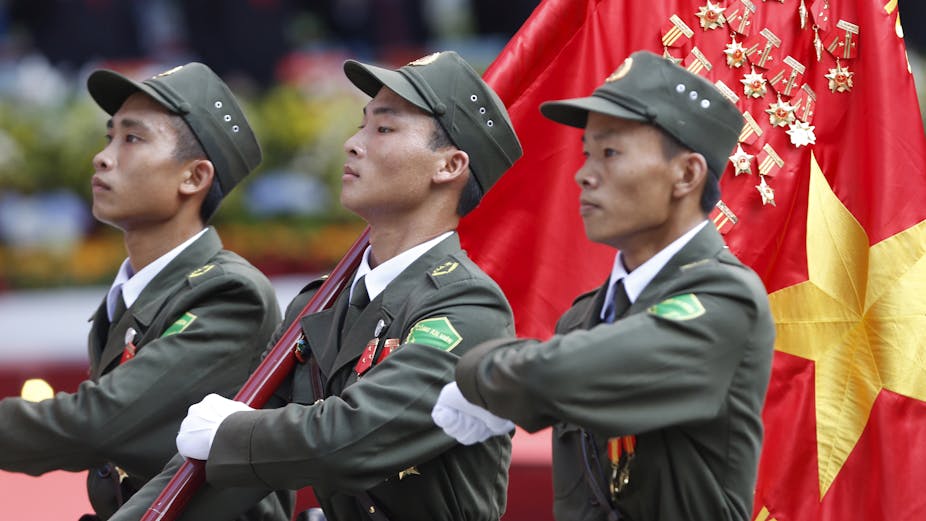One April morning in the 1990s during my commute to work on a project teaching business concepts and practices to professors and managers at the National Economics University in Hanoi, I saw red.
Hundreds of Vietnamese flags, red with a yellow star, flapped on poles or draped from windowsills of apartment buildings, offices, schools, and hospitals. When I got to work, I asked a colleague what was going on.
“Today is April 30, Liberation Day, when we defeated the American imperialists in 1975.”
Ouch.
Lopsided war statistics
Vietnamese who fought in the war rarely mention it. But some of their children, now in their 40s, will talk when the moment is right.
Dinh remembers moving from village to village every few weeks to avoid bombs. Chien, born during the war, is proud of his name, which means “The Fighter.” His brother, born after the war, is named An, which means peace. Ha’s mother gave her a new dress on Liberation Day.
Statistics about the American War, as it’s called in Vietnam, are lopsided.

We lost nearly 60,000 lives and had about 2,600 MIAs. Vietnamese numbers are harder to come by. They range from 1.4 million to 3 million dead, and most Vietnamese claim 300,000 MIAs.
Devastating for both sides, to be sure. Yet, once the war ended, it seemed that while many Americans couldn’t let go, the Vietnamese moved on.

A few years later, they fought two more wars, with China and Cambodia. The “American War” was just one of many over the country’s 2000 years of history.
If you ask Vietnamese what they think about Americans, for years each gave the same response, which I call the Four F’s: “We never forget, we try to forgive, we make friends with our enemies and we look to the future.”
So after the war, they got to work, looking to the future, and it’s paid off.
An economy on the move
The men I worked with in 1994, just after the US lifted the trade embargo with Vietnam, wore rubber-tire-soled sandals and their one-size fits all belts wrapped almost twice around their thin waists.
The women wore white shirts and black trousers, every day.
When I asked what they wanted from the newly launched “market oriented economy under socialist guidance,” the men said “leather shoes.” Women wanted to have a second child.
They now have leather shoes, more children and an economy on the move. Since July 1995, when the US and Vietnam reestablished diplomatic relations, to 2014, per capita GDP in Vietnam grew from $288 to $1910.

By 2011, according to the Vietnam Chamber of Commerce and Industry, 500,000 small/medium sized enterprises employed 50% of Vietnam’s labor force and represented 40% of consumer goods and exports.
In the last decade, Vietnam has become a leading world exporter of rice and coffee and counts the US as one of its biggest trading partners.
But again the statistics, while small relative to our other trading partners, seem lopsided.
Vietnam exports $30 billion to the US and imports just under $6 billion. We buy lots of apparel and footwear, they go for infrastructure and education.
This reminds me of one of the first Vietnamese people I met in 1994 who said, “We conquered you in the war and we will conquer you in business.”
Should we worry? I don’t, largely because of entrepreneurs like Nguyen Trong Khang.
The ‘bridge generation’
Like so many who were children in the war, Khang has changed his life and Vietnam’s.
In 1999, he founded a firm producing identity cards that now employs over 400 people, received a national award as one of the top five entrepreneurs in the country in 2014, and bought a house in Portland, Oregon, near his son’s college.
Khang has also started a scholarship to help young Vietnamese study in the US. The number of young Vietnamese who want study in America is steadily increasing. In 2013 the US was the second largest recipient of Vietnamese students (after Australia) with over 19,000.
Khang and others like him represent Vietnam’s “bridge generation,” those who stand with one foot in the memory of the war and the other planted in the future, making life better. They also help create a bridge between our countries.
So next time I’m in Hanoi on 30 April, I’ll be delighted to celebrate Liberation Day with the Vietnamese. Maybe I’ll do it today in the US as well.

